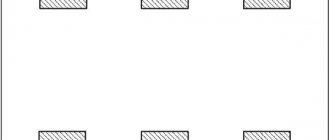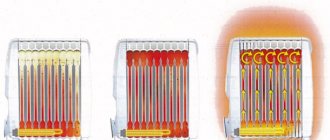Very often, with the onset of frost, apartments also become quite cool: the radiators do not burn at all, the central heating system cannot cope. The problem of heating a room is even more acute in private homes. As a rule, additional heating equipment from fan heaters to electric convectors comes to the rescue, with the latter type of heater gaining more and more popularity. Perhaps the convective-infrared heater deserves special attention for its technical characteristics and quality of work.
What is the difference between an infrared heater and a convector?
Convectors
Convector heaters are available in electric and gas models. In residential settings, electric models are used. They are used in apartments, houses, country houses, office premises - in all buildings where electrical power can be connected.
The principle of operation of the convector . The convector heats cold air and distributes the heated air evenly in the heated room. Convectors do not emit heat, like many heating devices, but fill the room with it.
The device is placed at a height of no more than 15 cm from the floor level. Then simple laws of physics apply: cold air is at the bottom, because it is heavier than warm air - it enters the heater through a special grille and passes through the radiator. Passing through the radiator it heats up and enters the room. Warm air rises. As it cools, it lowers and the procedure is repeated, ensuring constant heating of the air in the room.
Design features . The heater consists of two main parts: a housing (convection chamber) and a built-in heating element. The heating element does not contact the metal body, so grounding is not required. Between the heating element and the body there is a protective layer made of special heat-resistant plastic. The air exchange process is carried out naturally, without additional parts inside the structure. Due to the absence of a fan, the convector operates silently.
Modern convectors are equipped with a thermostat, which ensures that the air temperature in the room is maintained with a high level of accuracy. The user sets the desired temperature, and the thermostat turns the device on and off as needed. Control modules allow you to combine several convectors into a group and fully control the microclimate in the house.
Convectors are equipped with various additional options that help ensure maximum indoor comfort. The device can be equipped with a timer, electricity connection indicators, a remote control device, and an air humidifier.
1. Front panel. 2. Grill with guides for the release of warm air.
3. Power button. 4. Temperature adjustment.
5. Electronic module. 6. Closed heating element. 7. Temperature sensor.
Infrared heater
An infrared heater is a modern heating device used to heat rooms for various purposes.
The operating principle of an infrared heater . The operating principle of this device can be compared to the sun's rays. An infrared heater works by heating objects in a room using infrared radiation - in turn, they release heat to the air. This allows you to heat small areas or create local heating. To obtain the desired effect, you do not need to wait until all the air in the room or office is heated.
Design features . The main structural element is the emitter, which emits infrared radiation and provides heating. Depending on the type of device, a halogen, carbon, ceramic or tubular heating element is used.
The reflector is a structural part that provides directional heating and protection against overheating of the housing. Made from modern materials with a high level of thermal resistance in a parabolic or linear shape.
A protective part in the form of a grille or partition to protect against direct contact with the hot surface of the emitter, a necessary element for a device used in a residential apartment or house.
1. Carrying handle. 2. Protective grille.
3. Emitter. 4. Power button.
5. Reflector. 6. Leg.
How does it work
Note!
The operating principle of the described device is based on the phenomenon of convection. From the physics course we know that cold air is heavier than warm air, it is located in the lower part of the room, the heated air masses gradually rise upward. Due to such movements, the entire air space in the room is heated.
The convector operates according to a simple algorithm. At the bottom of this device there is a heating element (it is also called a heat exchanger). To increase the volume of air passed through, this part is made in the form of a radiator with several flat fins. The angle of their inclination regulates the direction of heated air flows. The heat exchanger is covered by a protective metal casing.
According to the energy carrier used, all convectors can be divided into the following types:
- Devices powered by electricity;
- Gas convectors;
- Mermen.
Design of a convector heater
At the top, as well as at the bottom of the convector body, there are several holes for sucking in cold air and transporting heated air. Structurally, it is made in such a way that the body of our device does not have direct contact with the heat sink, so the casing does not heat up and does not transfer heat. A similar transfer of heat resources occurs in water and oil radiators.
In everyday life, electric type convectors are mainly used. Water appliances have lower efficiency indicators; they differ from analogues in their significant overall dimensions, so they are installed in places where traditional water radiators are installed in niches under windows. Gas equipment, despite the possibility of saving energy resources, for some reason is not popular among consumers.
Heating speed and features
Convectors work by filling the room with warm air through natural convection. These devices do not use fans or other additional elements that speed up the heating process. Therefore, the heating rate is low relative to infrared devices.
The operating principle of an infrared heater provides fast and targeted heating under the influence of infrared radiation. But first of all, objects, walls and people heat up, and from them the air in the room is heated. It has been experimentally confirmed that heating is felt within 27 seconds. The targeted action of an infrared heater allows you to achieve a comfortable temperature in the area of the room where people are located. In this case, the accumulation of warm air near the ceiling will be minimized.
Differences in heat distribution when using a convector and ceiling infrared heater.
A person will feel the heat most quickly from an infrared heater, but if we talk about uniform heating of the air throughout the entire room, then a convector will handle it faster. The targeted action of an infrared heater allows the use of these devices in places where there are drafts - on terraces, gazebos and industrial premises. The convector is able to provide uniform heating of the air in a closed room.
Fan heaters - inexpensive, but noisy
These devices are available in various sizes. The larger the fan blades installed inside the case, the larger the dimensions of the device. The heating air passes either through a metal spiral or through a ceramic heating element. Heat ventilation is the fastest way to raise the air temperature in a room.
We turned on the device - and after half an hour the room became noticeably warmer. Moreover, from 1 to 1.5 kilowatts of power of such a device is enough for not 10, but 25 square meters of area.
The simplest, portable fan heater.
pros
- They are the cheapest - models with a spiral can cost 500 rubles, the price of devices with a ceramic plate starts from 1.1 thousand rubles.
- They are the most economical - they consume about 1-1.5 kilowatts of power.
- They have a thermostat that instantly turns off the device if it overheats.
- They are very light and easy to carry from room to room.
Minuses
- These heaters are too noisy.
- They overheat quickly, so they cannot be used continuously for long enough.
- They raise a lot of dust.
Which heater is more comfortable to use?
Electric convectors are presented in two model options, based on installation features. Wall-mounted models are attached to the wall at a height of 10–15 cm from the floor. Installation does not take much time. Once the device is mounted on the wall, it does not interfere with movement in the room and is not noticeable.
Floor-standing models are compact, equipped with wheels or stand legs. Due to its light weight and parameters, the device is easy to transport from one room to another. The presence of additional functions increases ease of use.
Infrared heaters are divided into mobile and stationary. Mobile models of infrared heaters can easily be moved within a room or transferred to another room. However, the body of an infrared heater often gets very hot, so you need to be careful when changing the orientation of the device or moving it to another room. Although the protective mesh protects from direct contact with the emitter, it has a fairly high temperature.
As for stationary infrared heaters, they are practically no different, in this regard, from convector heaters. They are installed on walls or ceilings and do not cause any inconvenience to the occupants of the room.
Convectors will be more comfortable to use. They do not require the same control as infrared devices. A convector can easily be left unattended, while a powerful infrared heater can emit a large amount of heat, which can lead to negative consequences for both a person and nearby surrounding objects. Both devices are silent. However, users note that some models of infrared heaters produce a cracking sound when heating and cooling, caused by thermal expansion of parts.
How to choose for a dacha
When choosing the heating device in question for use in the country, you should pay attention to the following parameters:
- Safety of use of the device;
- Durability indicators;
- Price;
- Economical use of electricity or other coolants.
Convector heater in the interior of a room
When choosing between a wall-mounted and floor-mounted model, you need to take into account the fact of using the device. Many types of electric convectors are fixed to the wall surface, but if there is a need to move the heating device, it will be necessary to purchase additional equipment (wheels, protection against heating during accidental tipping).
The height of floor convectors does not exceed 20 centimeters, they are narrow and long. Wall-mounted models reach 50 centimeters in height. According to experts, devices that are located as close to the floor surface as possible have maximum efficiency, because heated air moves from top to bottom. In this regard, it is better not to buy wall-mounted equipment, or install such devices as close to the floor surface as possible.
When purchasing such devices, you need to pay special attention to the material and workmanship of the case, its overall dimensions, and design. Here you need to take into account the height of the body: the larger it is, the greater will be the air flow speed or the convector properties of the heater
Skirting convectors up to 20 centimeters in height heat the air well due to their significant dimensions; their length can reach up to 2.5 meters. A tall (up to 60 centimeters) heating device, in which the speed of air flow increases, will be more compact.
It is better to install the convector closer to the floor
Which heater is safer to use?
Electric convectors meet all fire safety requirements and are equipped with overheating protection. Thanks to the special protection of the heating element, the heating part does not touch the metal body, so there is no need for grounding. The surface of the convector does not overheat. Wall-mounted options are securely mounted on the wall, while floor-standing models are stable.
The heating element of an infrared heater has a high temperature, so its surface is covered with a partition or mesh - this protects against burns if accidentally touched. The models are equipped with overheating and fall protection functions. Radiation is safe for humans, but it is not worth abusing it and staying under its influence for a long time.
In terms of safety, the convector will be much more reliable. It does not have very hot elements and does not produce radiation. Infrared heaters, when used correctly, meet fire safety standards, but they are more fire hazardous devices. In addition, it should be mentioned that being under too intense infrared radiation for a long time is not very good for health. This can be compared to being under the scorching sun for a long time. Of course there will be no lethal outcome, but a headache can be guaranteed.
Historical reference
Situations often arise when the installation of additional heating equipment is necessary. For example, when the heating system does not have enough power to heat the room, or it is cold winter outside.
Many people are trying to make homemade devices. Previously, simple fan heaters were used; in some houses, the devices were preserved, popularly referred to as “goats”.
With the onset of the 90s of the last century, electric convectors began to appear on the shelves. The production of these devices was carried out abroad, the equipment was expensive.
The devices were hung on the wall. The device is easy to operate and does not consume much electricity.
Convective, convective-infrared, and infrared designs have appeared on the market. The devices are even more economical, compact, and simple.
Which heater is more environmentally friendly?
The specifics of the convector operation mean that when air moves in the room, dust will rise. Convection is present when the infrared device is operating, but it is weakly expressed.
You can often hear the opinion that one or another type of household heater burns oxygen. In fact, not a single heater operating from an electrical network burns oxygen because there is no open combustion. That is why this feature cannot be used as an advantage of some and a disadvantage of other types of heaters.
Both devices do not emit harmful substances during their operation, however, dust raised during operation of the convector can be very harmful to allergy sufferers. Intensively working convectors are able to reduce the humidity level in the room more than infrared models. An infrared heater does not cause strong convective movement of air masses. But here it is necessary to ensure that dust and other small objects do not fall on the emitter, which, after turning on the heater, can burn out creating an unpleasant odor.
Pros, cons
Pros:
- Long service life, multifunctionality.
- Minimal heat loss.
- Economical.
- Safety.
- Convenient design.
- Fast heating.
Convective IR device in the interior
Cons:
- Burns oxygen.
- Price.
When choosing a heater you need to consider:
- area to be heated;
- the amount you have.
Saving on electrical appliances is unlikely to lead to good results. The cheaper the device, the shorter its service life. The quality may be poor.
Heater dimensions
The convectors are thin, but quite large in height and width of the device. Due to their small thickness, wall-mounted models are practically invisible after installation.
The dimensions of infrared devices depend on the type and technical features of the device. The most compact models are portable type for spot heating.
Ceiling models have a considerable length (about 1 - 2 m). But they are placed in places where they do not in any way affect the area of the room.
Ceiling IR heaters.
If you compare mobile devices that can be moved from one room to another, then among them you can find infrared heaters of a very small size, approximately 25 - 30 cm in width and height. The operating principle of the convector does not allow these devices to be made as small. As a rule, convectors have a width of at least 44 cm and a height of at least 41 cm.
Dimensions
As a rule, models of electric convectors are quite compact in size and, when placed on the wall, take up minimal space.
They have a reduced depth; for some models the height can be 200 mm - for example, for NOBO convectors. In the photo: small electric convector; mobile and ceiling convectors
For infrared heater models, the dimensions depend on several factors - first of all, on the technical characteristics and purpose. Thus, mobile heaters designed for spot heating have fairly compact dimensions. Ceiling models, as a rule, are very long, however, given the location of their installation, such dimensions do not interfere at all, they only disrupt the aesthetic appearance of the room.
What is more economical: convector or infrared heater?
The level of energy consumption depends on the technical features of the device. According to research, using infrared models is more economical. Energy costs depend on the outside temperature, the desired indoor temperature, the level and quality of room insulation, window area and quality of double-glazed windows.
If you compare devices of the same power, they consume approximately the same amount of energy. The savings in using an infrared heater are achieved by the fact that to create a comfortable temperature in the room, it needs to operate for less time than a similar convector. Therefore, an infrared heater can be turned on for 20 - 30 minutes per hour, while a convector should work without interruption.
Floor-standing
The Ballu BEP/EXT -1500 convector is designed for heating rooms with an area of 20 m2. This device operates on a 220-volt power supply and has several power switching modes, which allows you to achieve the optimal temperature for heating the room. The model is equipped with special wheels for easy movement around the room, there is protection against overheating and accidental tipping, there is a control panel and a timer. The price of the model is 4220 rubles.
The advantages of the model are: beautiful appearance, a 3-year warranty on the product, low power consumption. Cons: clicking noises are heard when the thermostat operates, an unpleasant smell when first heating up, the display is bright.
Ballu BEPEXT -1500 differs from the previous model in size and power
The Electrolux ECH/AG-1000MFR convector with a power of 1 kW is designed for heating small, including wet rooms with an area of 15 m2. The controls in this device are mechanical, it is possible to control the temperature, there is a dust filter, as well as protection against overheating. The heater has a moisture-proof housing, the price of the model is 2,450 rubles.
The advantages of Electrolux ECH/AG-1000MFR include: excellent functionality, fast heating of the room, small overall dimensions, absence of foreign odors during operation of the device. No deficiencies found.
Convector Electrolux ECH/AG-1000MFR
Thermor Evidence 2 Elec 1500 with a power of 1.5 kW is designed for heating rooms with an area of 15 m2. This model has electronic control, it is possible to adjust the temperature automatically. The device has a waterproof housing and protection against overheating and frost. The price of Thermor Evidence 2 Elec 1500 is 4,400 rubles.
The main advantages of this convector are: beautiful appearance, ease of use, quick heating of rooms, and can withstand significant voltage drops. The disadvantages include the high cost of additional equipment.
Thermor Evidence 2 Elec 1500
The Hyundai H-HV14-20-UI540 heater with two heating elements of 1.25 and 0.75 kW can operate in three modes. At maximum power, it is possible to heat rooms with an area of 24 m2. The device connects to a 220-volt household power supply, is equipped with a digital display, and has mechanical control. The device has built-in overheating protection, its price is 1,590 rubles.
Hyundai H-HV14-20-UI540
The advantages of the Hyundai H-HV14-20-UI540 include affordable cost, the ability to save energy by turning off the temperature relay when the room is intensively heated, fast heating, small dimensions and weight. Disadvantages: foreign odors when the device is first started, high body temperature, thermostat clicks.
https://youtube.com/watch?v=ToD4P-MjqxU%3F
conclusions
As you can see for yourself, it is impossible to clearly decide which heater is better: infrared or convector. Both the first and second devices have a number of convincing advantages, and can fully reveal their potential in certain conditions. If we still compare, we would recommend using convector devices as an additional source of heat in enclosed spaces, and using infrared heaters if there is a need to create a local heated zone or heating in frequently ventilated rooms, as well as on verandas, gazebos, outdoor terraces. Well, it’s still up to you to choose what to buy!
Although a convector and an IR heater have the same purpose - to heat a room, they have completely different operating features and there is no point in comparing them. Let’s figure out in practice which infrared or converter heater should be chosen in this or that case.











